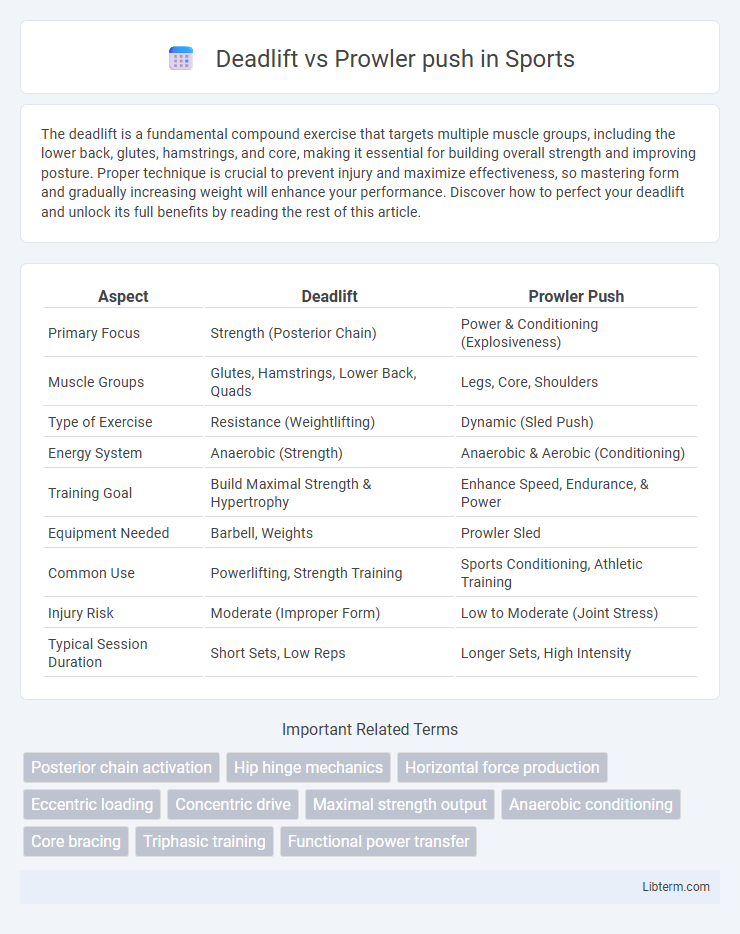The deadlift is a fundamental compound exercise that targets multiple muscle groups, including the lower back, glutes, hamstrings, and core, making it essential for building overall strength and improving posture. Proper technique is crucial to prevent injury and maximize effectiveness, so mastering form and gradually increasing weight will enhance your performance. Discover how to perfect your deadlift and unlock its full benefits by reading the rest of this article.
Table of Comparison
| Aspect | Deadlift | Prowler Push |
|---|---|---|
| Primary Focus | Strength (Posterior Chain) | Power & Conditioning (Explosiveness) |
| Muscle Groups | Glutes, Hamstrings, Lower Back, Quads | Legs, Core, Shoulders |
| Type of Exercise | Resistance (Weightlifting) | Dynamic (Sled Push) |
| Energy System | Anaerobic (Strength) | Anaerobic & Aerobic (Conditioning) |
| Training Goal | Build Maximal Strength & Hypertrophy | Enhance Speed, Endurance, & Power |
| Equipment Needed | Barbell, Weights | Prowler Sled |
| Common Use | Powerlifting, Strength Training | Sports Conditioning, Athletic Training |
| Injury Risk | Moderate (Improper Form) | Low to Moderate (Joint Stress) |
| Typical Session Duration | Short Sets, Low Reps | Longer Sets, High Intensity |
Introduction to Deadlift and Prowler Push
The deadlift is a compound strength exercise targeting the posterior chain, including the glutes, hamstrings, lower back, and core muscles, essential for building overall power and functional strength. The prowler push involves pushing a weighted sled, emphasizing lower body explosiveness, cardiovascular endurance, and anaerobic capacity. Both exercises complement athletic performance by improving muscle strength and conditioning but focus on different movement patterns and energy systems.
Muscle Groups Targeted
Deadlifts primarily engage the posterior chain, targeting the glutes, hamstrings, lower back, and core muscles while also involving the quadriceps and grip strength. Prowler pushes focus on the quadriceps, glutes, calves, and core, emphasizing explosive power and cardiovascular endurance through dynamic movement. Both exercises complement each other by developing strength and muscular endurance in overlapping yet distinct muscle groups.
Strength and Power Development
Deadlift primarily targets maximal strength by engaging major muscle groups like the glutes, hamstrings, and lower back, enhancing overall force production through heavy, controlled lifts. Prowler push emphasizes explosive power and anaerobic conditioning by driving the sled at high intensity, demanding rapid force generation and muscular endurance in the legs and core. Combining deadlifts with prowler pushes optimizes both strength gains and power output for athletic performance.
Cardiovascular Benefits
Deadlift primarily targets muscular strength and power but offers limited cardiovascular benefits compared to the Prowler push. The Prowler push engages large muscle groups with continuous, dynamic movement that significantly elevates heart rate, promoting improved cardiovascular endurance and aerobic capacity. Incorporating Prowler pushes into training routines enhances heart health and stamina more effectively than the primarily anaerobic deadlift.
Functional Fitness Comparison
Deadlift enhances overall strength by engaging major muscle groups such as the glutes, hamstrings, and lower back, promoting maximal force production and improving lifting mechanics. Prowler push emphasizes anaerobic conditioning, explosive power, and cardiovascular endurance by driving forceful leg and core engagement through dynamic, high-intensity movements. For functional fitness, deadlifts build foundational strength and muscular stability critical for daily activities, while prowler pushes develop movement efficiency, stamina, and real-world power application under fatigue.
Technique and Form Differences
Deadlift requires maintaining a neutral spine with a hip hinge movement to lift the weight from the ground, engaging the posterior chain including glutes, hamstrings, and lower back muscles. Prowler push emphasizes a forward-leaning stance with bent knees, driving through the legs and pushing the weighted sled while keeping the upper body stable to maximize power output. Proper technique in deadlift centers on grip and bar path control to prevent injury, whereas prowler push technique focuses on consistent foot placement and controlled breathing to sustain momentum.
Injury Risks and Safety Tips
Deadlifts carry a higher risk of lower back injury due to improper form or excessive weight, emphasizing the importance of maintaining a neutral spine and engaging the core. Prowler pushes reduce spinal load but can strain the shoulders and knees if performed with poor technique or on uneven surfaces, so ensuring controlled, steady movements and proper footwear is crucial. Both exercises benefit from gradual progression, proper warm-up, and listening to the body's signals to prevent overuse injuries.
Equipment and Space Requirements
Deadlifts require minimal equipment, typically a barbell with plates, and can be performed in limited space as long as there is enough room to safely lift and maneuver the bar. Prowler pushes demand a weighted sled designed for pushing, which requires a larger, flat surface area, such as turf or a smooth gym floor, to allow for proper movement and resistance. Equipment cost and space limitations often make deadlifts more accessible for home workouts, while prowler pushes are more common in specialized training facilities.
Programming for Goals: Fat Loss, Hypertrophy, Performance
Deadlifts primarily target hypertrophy and performance by engaging multiple muscle groups and promoting strength gains, making them ideal for increasing muscle mass and power output. Prowler pushes emphasize fat loss and conditioning with high-intensity, low-impact cardiovascular work that elevates heart rate and burns calories efficiently. Programming should include deadlift variations for building strength and muscle, while incorporating prowler pushes for metabolic conditioning and enhanced fat metabolism.
Which Is Best for You?
Deadlifts maximize total body strength by targeting the posterior chain, including glutes, hamstrings, and lower back, making them ideal for muscle building and power development. Prowler pushes emphasize conditioning and explosive leg drive, enhancing cardiovascular endurance and athletic performance through high-intensity, low-impact movement. Choose deadlifts for maximal strength gains and hypertrophy, while prowler pushes suit those seeking functional conditioning and speed endurance.
Deadlift Infographic

 libterm.com
libterm.com